Related Research Articles
Bolesław IV the Curly, a member of the Piast dynasty, was Duke of Masovia from 1138 and High Duke of Poland from 1146 until his death in 1173.
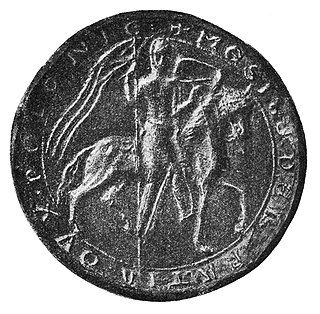
Mieszko III, sometimes called the Old, was Duke of Greater Poland from 1138 and High Duke of Poland, with interruptions, from 1173 until his death.

The Duchy of Teschen, also Duchy of Cieszyn or Duchy of Těšín, was one of the Duchies of Silesia centered on Cieszyn in Upper Silesia. It was split off the Silesian Duchy of Opole and Racibórz in 1281 during the feudal division of Poland and was ruled by Silesian dukes of the Piast dynasty from 1290 until the line became extinct with the death of Duchess Elizabeth Lucretia in 1653.

The Duchy of Silesia with its capital at Wrocław was a medieval duchy located in the historic Silesian region of Poland. Soon after it was formed under the Piast dynasty in 1138, it fragmented into various Silesian duchies. In 1327, the remaining Duchy of Wrocław as well as most other duchies ruled by the Silesian Piasts passed to the Kingdom of Bohemia as Duchies of Silesia. The acquisition was completed when King Casimir III the Great of Poland renounced his rights to Silesia in the 1335 Treaty of Trentschin.
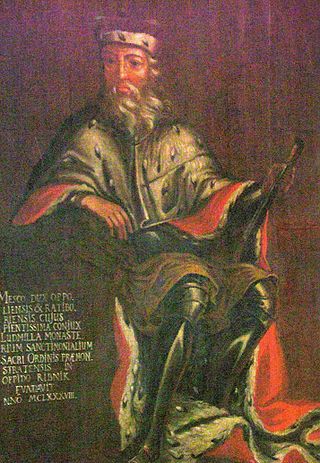
Mieszko IV Tanglefoot was Duke of Kraków and High Duke of Poland from 9 June 1210 until his death one year later. He was also Duke of Silesia from 1163 to 1173, Duke of Racibórz from 1173, and Duke of Opole from 1202.

Bolesław I the Tall was Duke of Wroclaw from 1163 until his death in 1201.
Mieszko is a Slavic given name of uncertain origin.
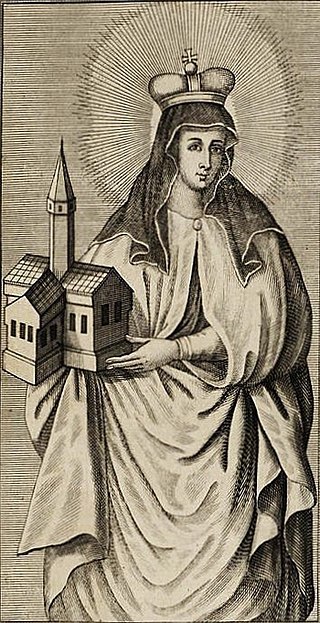
Anne of Bohemia, a member of the Přemyslid dynasty, was Duchess of Silesia and High Duchess of Poland from 1238 to 1241, by her marriage to the Piast ruler Henry II the Pious. She was celebrated by the community of Franciscan nuns at St Clara of Prague Abbey in Wrocław as their founder and patron.

Henry the Bearded was a Polish duke from the Piast dynasty.

The Duchies of Silesia were the more than twenty divisions of the region of Silesia formed between the 12th and 14th centuries by the breakup of the Duchy of Silesia, then part of the Kingdom of Poland. In 1335, the duchies were ceded to the Kingdom of Bohemia under the Treaty of Trentschin. Thereafter until 1742, Silesia was one of the Bohemian crown lands and lay within the Holy Roman Empire. Most of Silesia was annexed by the King of Prussia under the Treaty of Berlin in 1742. Only the Duchy of Teschen, the Duchy of Troppau and the Duchy of Nysa remained under the control of the Bohemian crown and as such were known as the Duchy of Upper and Lower Silesia until 1918.

The Silesian Piasts were the elder of four lines of the Polish Piast dynasty beginning with Władysław II the Exile (1105–1159), eldest son of Duke Bolesław III of Poland. By Bolesław's testament, Władysław was granted Silesia as his hereditary province and also the Lesser Polish Seniorate Province at Kraków according to the principle of agnatic seniority.

Mieszko I of Cieszyn (Polish: Mieszko cieszyński, Czech: Měšek I. Těšínský, German: Mesko I (Teschen); also known as Mieszko I of Opole; 1252/56 – by 27 June 1315), was a Duke of Racibórz during 1282–1290 (with his brother as co-ruler) and the first Duke of Cieszyn since 1290 until his death.
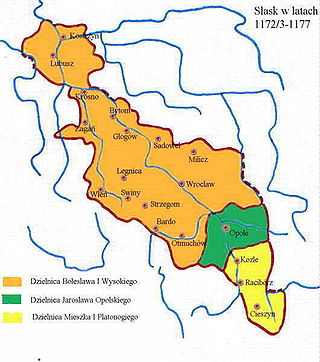
Duchy of Opole was one of the duchies of Silesia ruled by the branch of Polish Piast dynasty. Its capital was Opole in Upper Silesia.

Casimir I of Opole, a member of the Piast dynasty, was a Silesian duke of Opole and Racibórz from 1211 until his death.
Casimir of Bytom was a Duke of Opole during 1282–1284 and Duke of Bytom from 1284 until his death.
Bolko I of Opole, was a Duke of Opole from 1282, Niemodlin and Strzelce Opolskie until his death.

Przemysław of Racibórz was a Duke of Racibórz since 1282 until his death.
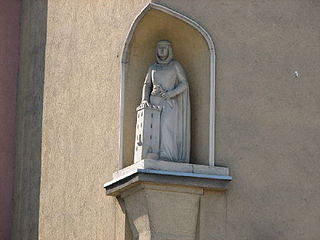
Constance was a Polish princess from the House of Piast and sovereign Duchess of Wodzisław Śląski from 1324 until her death.

The Duchy of Opole and Racibórz was one of the numerous Duchies of Silesia ruled by the Silesian branch of the royal Polish Piast dynasty. It was formed in 1202 from the union of the Upper Silesian duchies of Opole and the Racibórz, in a rare exception to the continuing feudal fragmentation of the original Duchy of Silesia.
Euphrosyne was a princess of Racibórz and Opole, and probably also of Kraków between 1210 and 1211, the daughter of Duke Mieszko IV Tanglefoot and Ludmila.
References
- ↑ W. Brzezinski, Pochodzenie Ludmiły, żony Mieszka Plątonogiego. Przyczynek do dziejów czesko-polskich w drugiej połowie XII w. [English: The origins of Ludmila, wife of Mieszko Tanglefoot. Contribution to the Czech-Polish history in the second half of the twelfth century] [in:] Central and Eastern Europe in politics Piast, edited by K. Zielińska-Melkowska, Toruń, 1997, pp. 213-219. With the view that agreed to D. Dabrowski, Genealogy Mścisławowiczów. The first generation (the early fourteenth century), Krakow 2008, p. 650.
- ↑ J. Horwat, Górnośląscy princes of the Piast dynasty, pp. 21-22.
- ↑ N. Mika, Mieszko, son of Wladyslaw II the Exile, and Duke of Raciborz and Krakow - Polish policeman ruler, Racibórz 2006, pp. 86-90.
- ↑ Her parentage is uncertain, she is only known from a document of Mieszko II the Fat, who called her his aunt (Amita), which means that she could be also the sister of his mother Viola. See MIESZKO I (IV) PLĄTONOGI (LASKONOGI, RACIBORSKI)